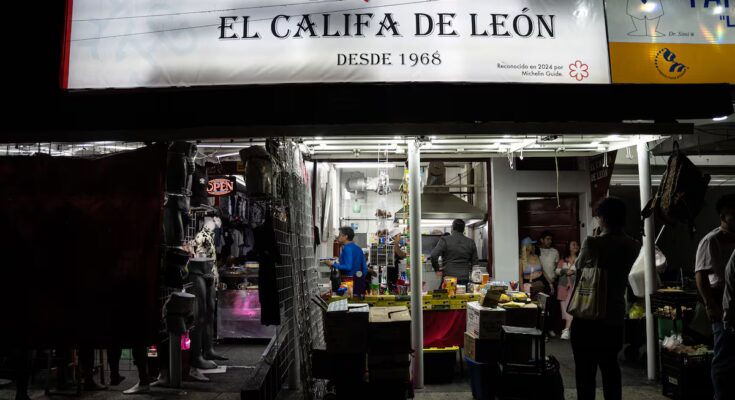Two hours before opening at University Park in Dallas, there was already a line stretching more than two blocks in front of El Califa de León, the renowned one-Michelin-star Mexican taqueria. Expectations were sky high for the restaurant, whose original is based in Mexico City and last year received one of the highest honors in the culinary world. The inauguration is part of a temporary collaboration with the GrinGO company, scheduled from 17 to 25 October. But what was supposed to be a strategic, unique and exclusive culinary experience to showcase the “flavor and quality” of a traditional gaonera the taco, the restaurant’s signature dish, turned into a disastrous event in which diners had to wait hours for service that, in some cases, they never received. Mario Hernández, owner of the company founded in 1968, had to make the difficult decision to close his pop-up business in Texas just 48 hours after opening and to retire before his company’s reputation was damaged. The Michelin star, awarded in May 2024, opened an international showcase to him, but also entrusted him with the weight of responsibility that comes from meeting expectations and respecting quality standards.
“For us it is a great joy and a great responsibility,” Hernández told local media gathered at the inauguration. However, between the second and third days, the complaints began to increase. Some people waited five to seven hours only to find they hadn’t received the food they were waiting for. Others made reservations via the app for a specific time, only to receive an order of three tacos two hours later. There were also those who complained about the price of the food. THE gaonera taco, made with whole beef steak; THE cut (pork chop) taco; or the rib (beef ribs), all cooked on a griddle with just salt and a squeeze of lime, sold for $10, $9 and $12 respectively. That’s nearly double or triple, depending on your choice of meat, the price in the capital.
Several factors contributed to Califa de León’s first fiasco outside Mexico. One of the main ones was a gas leak which forced the postponement of the service on the second day. This issue was not properly communicated, so many people were unaware and arrived at the restaurant only to find it closed. Once the problem was resolved, the restaurant reopened on the third day, but the number of people waiting from the previous day continued to grow, forcing the kitchen to remain closed for several hours to stock up and prepare food.
“We paid $340 for a reservation for four people. It included an appetizer, four Michelin-starred tacos, a dessert and drinks. We received two tacos. The gaonera taco was very dry and I liked the short rib tacos, but they were cold. It was clear they were short-staffed and should have prepared better,” says Amanda J., a diner who visited the restaurant.
The culinary venture in Texas was organized by GrinGO, a travel and safety app for American and Canadian tourists in Mexico. Hernández says he has no complaints about the professionalism of the pop-up store manager who brought El Califa de León to Dallas. He admits that he has received good promotion on social media, radio and television. However, he acknowledges that his partner, whose name he does not want to reveal, has not been forward-thinking in operational aspects. EL PAÍS contacted GrinGO, but had not received a response at the time of publication.
“We weren’t adequately prepared and didn’t take into account the amazing response we received from our customers. My wife noticed and said to me, ‘Hey, people are really joking with the name El Califa.’ I took that to heart and said, “Okay, you’re absolutely right.” We shouldn’t play with this name and the best thing to do is cancel, with all due respect, because we didn’t have the necessary tools to overcome this situation,’” Hernández explained by phone.
In Mexico City, El Califa de León has become an international landmark on Avenida Ribera de San Cosme, a famous spot in the capital, in the San Rafael neighborhood, known for the semi-permanent tianguis (open-air market) that occupies much of the south side of the street. The first thing that catches your eye when entering his small shop, which has remained in the same location for almost 70 years, are the two Michelin Guide signs that highlight the award received in 2024, and confirm this year that it is the only taco stand in the world with the coveted star. The lines aren’t as long as last year, but customers still pack the place every Thursday at lunchtime. The cuts of meat are displayed and explanations are available in both English and Spanish for local customers and those traveling from out of town.
In front of the griddle where the cuts of meat are cooked, seasoned with coarse salt and a squeeze of lime juice, and where the tortillas are also prepared to order, a Japanese man, a Puerto Rican couple and an American customer wait for their order. The three agree that the tacos lived up to their expectations.
Andrés “Peluche” Torres, expert taster of garnacha—Mexican Street Food—and content creator, believes that one of the positive aspects of a recognition like that given by the Michelin Guide is the added value it attributes to the work of all those behind this activity and the street food industry. “Most Mexicans appreciate this type of food, but what this type of recognition allows is for other cultures and social classes to recognize it and venture out to try it. Additionally, I think it’s important that people from outside the area or other neighborhoods also see what’s out there beyond the traditional neighborhoods where the food is usually recognized,” he explains over the phone.
Celebrities are also regulars here. Paco Ayala, bassist and one of the singers of the rock band Molotov, believes that the Michelin is deserved. He says he is a regular customer and that what he likes most is the quality of the meat and sauces, the traditional fresh green and the red, which “are still delicious”. He does not believe the recognition has caused a decline in quality or customer service.
Mercedes Hinojosa, sociologist and professor at UNAM, emphasizes that, ultimately, cooking is a dynamic and social experience. It’s a matter of taste, he explains, which is tied to one’s perspective, experiences, biology, taste buds, personal preferences or memories. He agrees with Torres that the Michelin Guide continues to achieve its goal of attracting “bourgeois consumption” and encouraging travel, but warns that it is important to ensure that the award does not only evaluate certain types of food.
“Mexican cuisine is very varied and also very dynamic. It has always reinvented itself. A negative aspect would be to establish a standard that aestheticizes and standardizes all foods. It is important to recognize and celebrate the culinary diversity of the country; pozole what we eat in the center is not the same as the pozole we eat further north. The Michelin star has a positive side, but for me the negative side would be to establish the stars as a standard of what food should be, as a homogenization of what we eat,” Hernández adds by phone.
Hernández is aware of the pressure he is under. His family’s goal is to keep the star for as long as possible. But despite this latest setback, he is also ambitious: “To gain another star, not just keep it. This is my goal and the goal of the people who work with me. This is the challenge we face right now. It’s a great responsibility.”
Sign up to our weekly newsletter to get more English-language news coverage from EL PAÍS USA Edition



